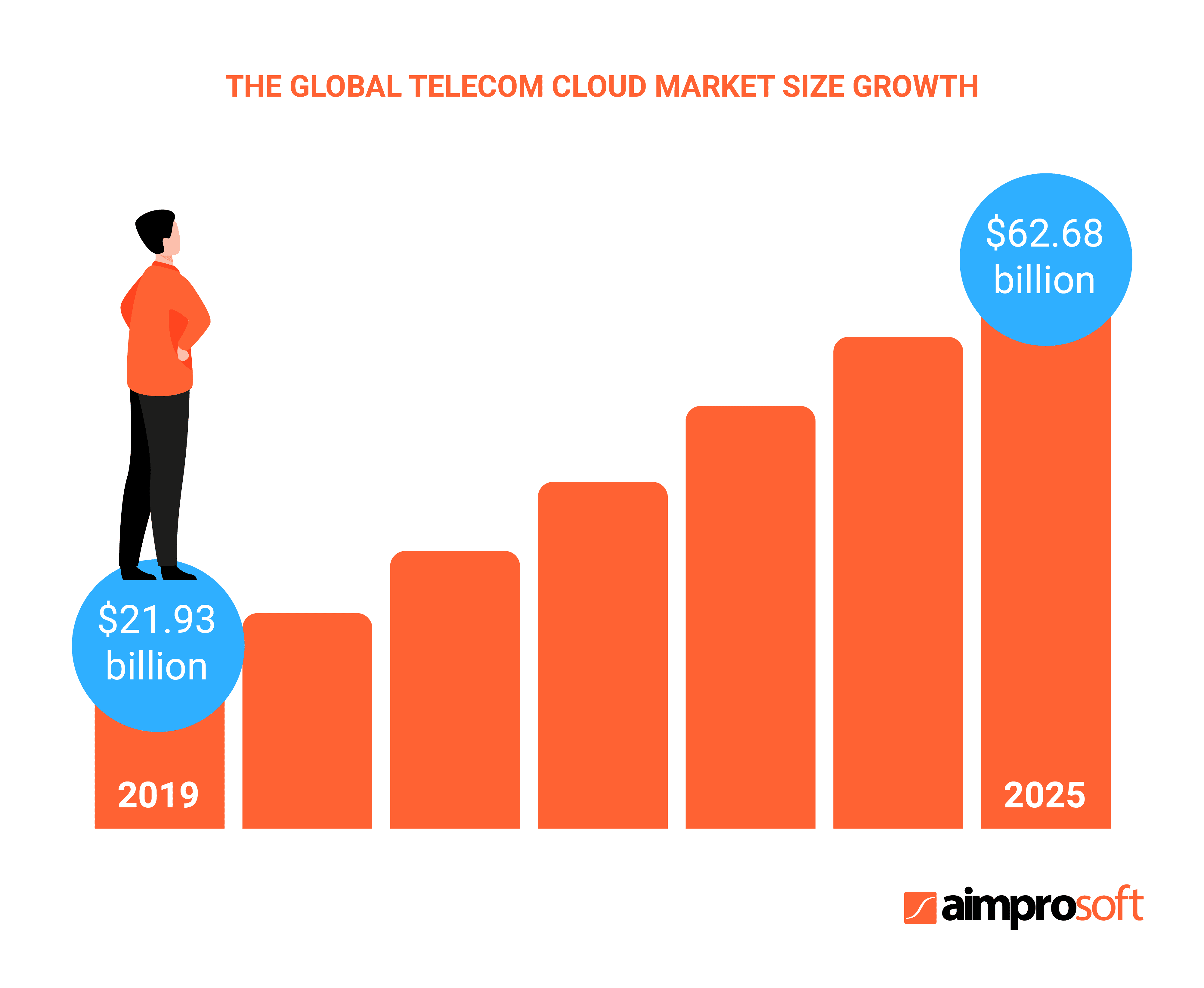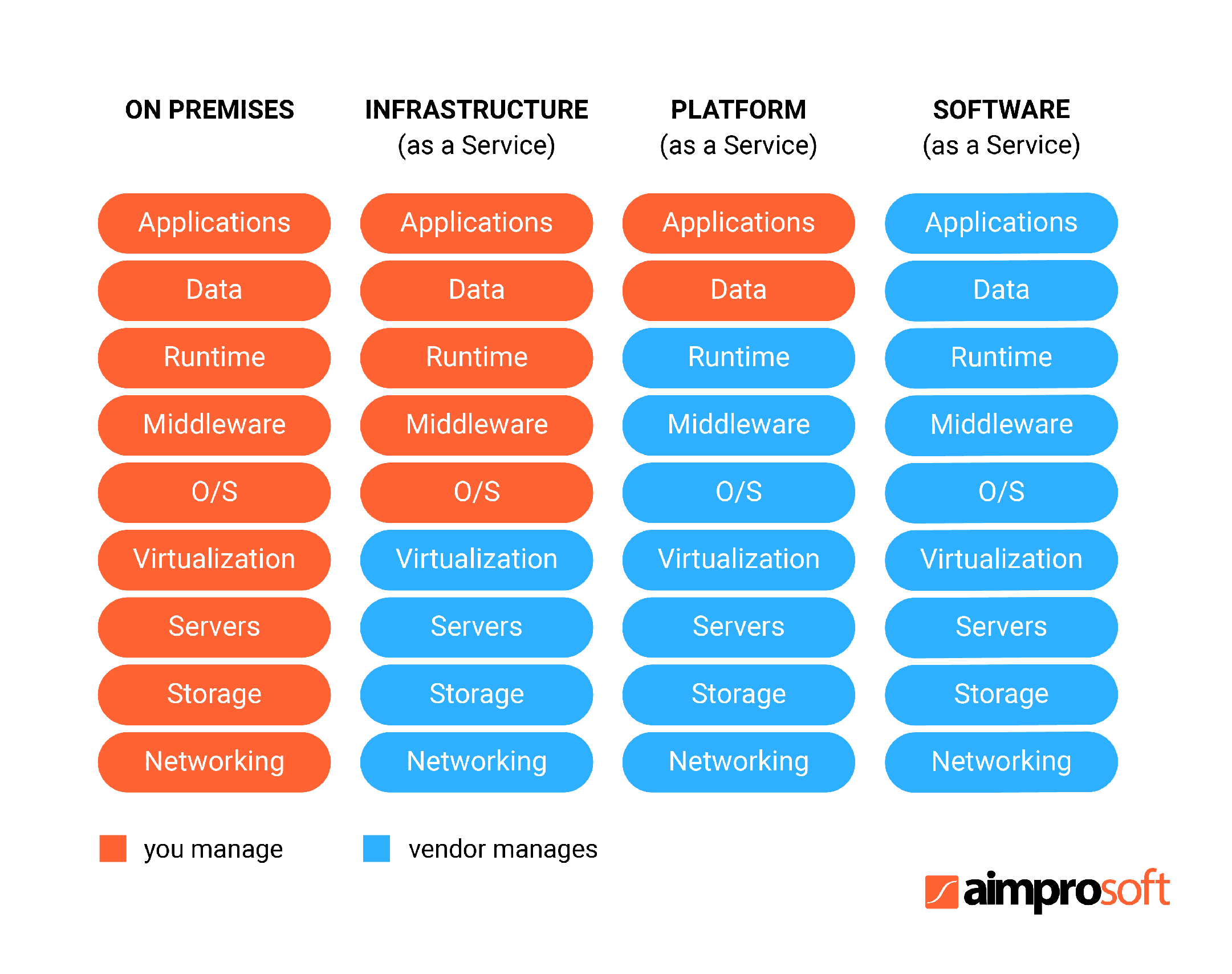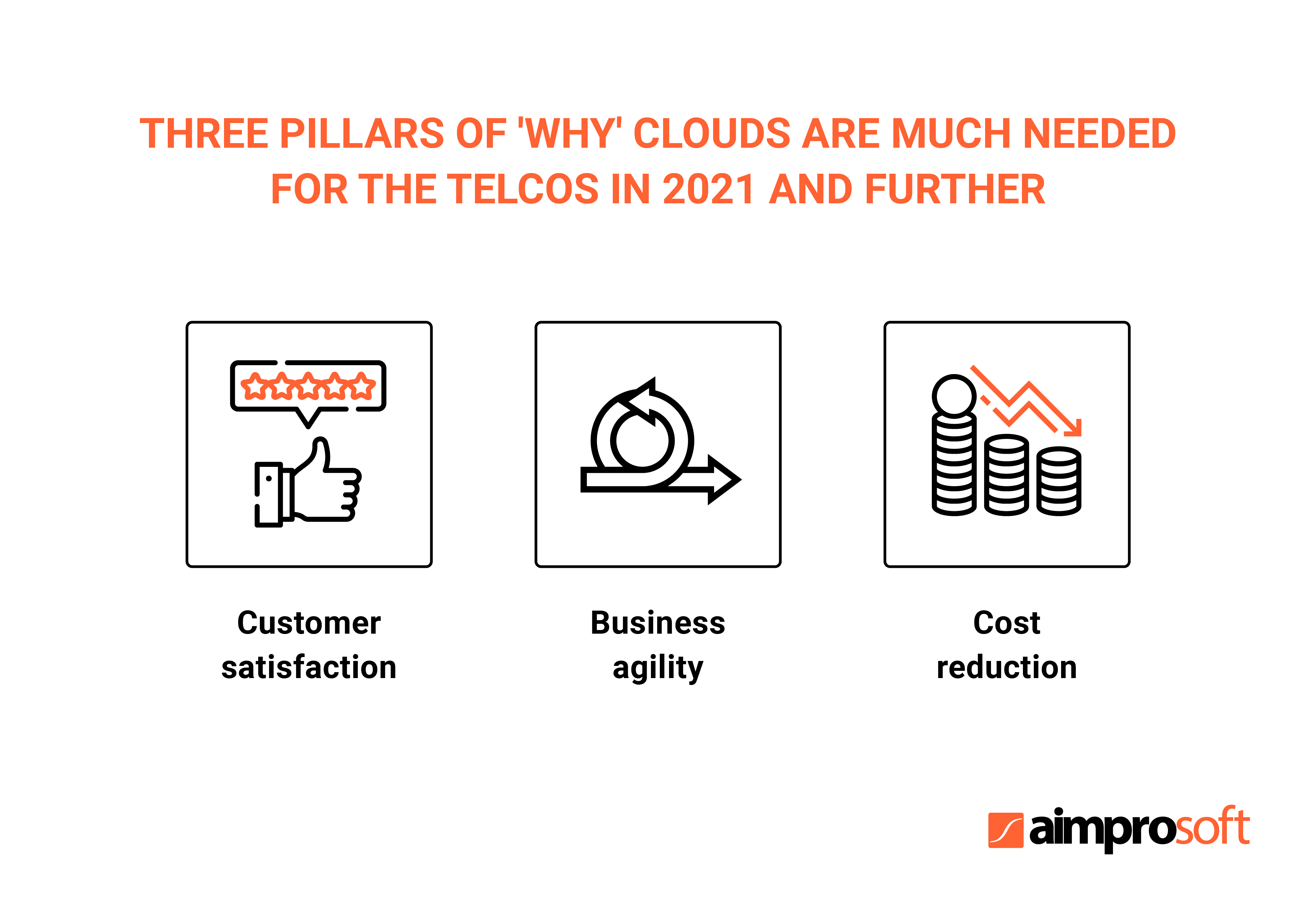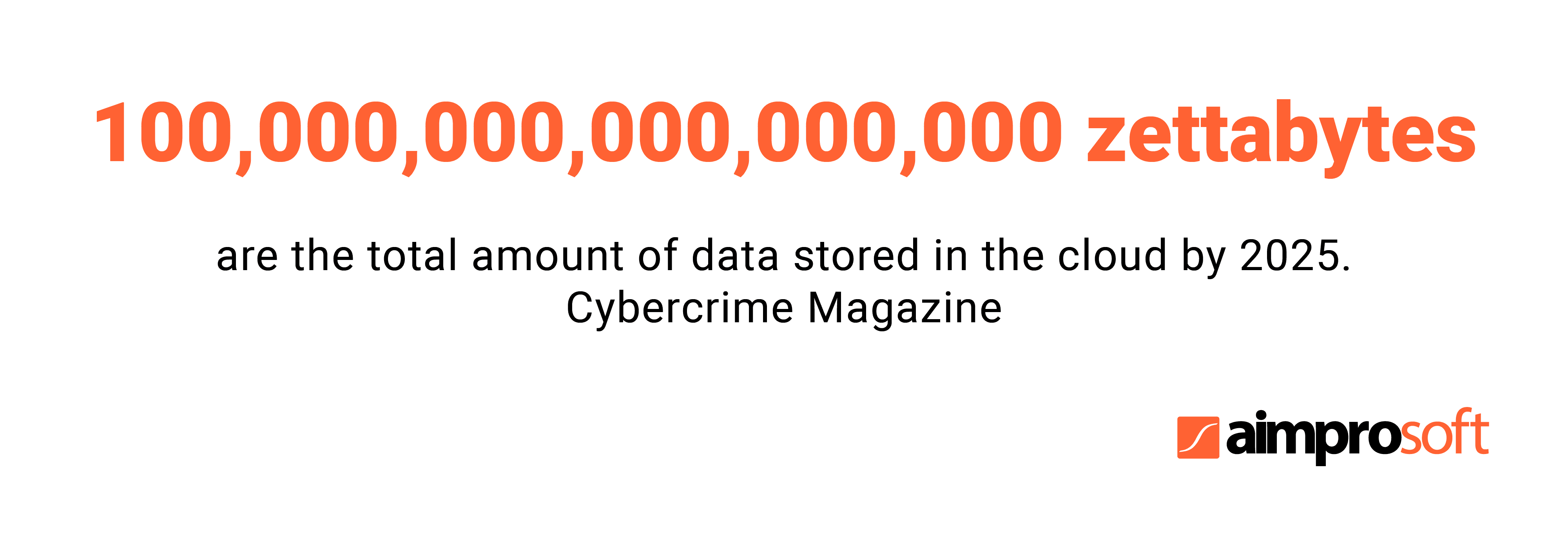Cloud Computing for Telecom Industry: Role, Benefits and Ways of Deployment

Key takeaways
-
Cloud computing is estimated at $300 bln of revenue in the context of IT services in 2020. Know how cloud for telecom operators opens up the new world of B2B and B2C communications.
-
The global telecom cloud market impresses with figures nine zeros growth. You may define what cloud computing in telecommunications means and how it works below.
-
Learn more about the values clouds bring to telecom operators providing new opportunities for business and consumers.
-
Stay keeping posted about pacesetters and unexpected strategy chances that may happen during transformation cloud and telecom.
-
Read on how Aimprosoft can help with a shift from traditional on-premises model to the progressive cloud deployment.

Telcos have to compete with web scale cloud-based companies like WhatsApp, Skype, Telegram, Viber, iMessenger, and Google hangouts that have become the main pocket communication channels for everyone. They pose a great threat to telecommunications.
The figures prove their undisputed popularity: in 2020, cloud computing brought $300 bln of revenue as a part of IT services. That shows the growing trend of transformation of communication services at all. Meaning, telecom has to accelerate, and to do that is possible by deploying infrastructure in the cloud.
$900 bln spendings worldwide are forecasted from telecom providers in mobile capital expenditures (CapEx) for 2021-2025, approximately 80% of which will be focused on 5G run on cloud infrastructure.

What Is Cloud Computing in Telecommunications?
Generally, telecom software runs on dedicated computer appliances. Service providers who want to advance agility and stay affordable at operational spendings consider using cloud infrastructure instead of traditional network architectures.
Cloud computing in telecom is a software-defined infrastructure that allows telcos to store and process data remotely in the data processing centers, expand services quickly and react to the surge in changes. It is a keystone of telecom digital transformation from CSP to a digital service provider (DSP).
Cloud computing types
There is three cloud computing models widely adopted by telcos to facilitate business growth:
-
Infrastructure-as-a-service (IaaS) when the telecom provider uses the computing resources of the provider (server, network infrastructure, data storage);
-
Platform-as-a-service (PaaS) when the PaaS supplier provides the telecom provider with access to the use of the software platform;
-
Software-as-a-service (SaaS) when a telecom provider can use a vendor’s off-the-shelf application.

Indeed, cloud computing grants unfettered powers to the telecom sector: providers of communication services can store and compute data, build networks, keep databases, and cope with other telecom cloud services being accessed through the Internet autonomously. It can be a universal computing tool with broad comprehension.
To harness cloud computing, telcos can use cloud computing provider services. For example, Microsoft Azure, Amazon Web Services, Google Cloud, IBM Cloud, Alibaba are public clouds intensively used by telecom providers Raketen, Vodafone, Verizon in terms of on-demand infrastructure. The giants thus cut costs on operations and life-cycle management.

Telecom providers do not stand still. By 2027, Vodafone will transfer data from its servers to Google Cloud under the Nucleus cloud-based storage and analytics portal. The purpose of such an undertaking is to achieve data processing up to 50 terabytes per day, which is unfeasible on-premises. AT&T joined forces with Microsoft to move and manage its 5G mobile network using Microsoft Azure, which is expected to cut down engineering and telecommunication software development costs due to a hybrid and hyperscale infrastructure.
If you’re not cloudified yet, you probably do not know the major benefits of cloud computing for the telecom industry yet. Let’s move to a rundown of pros, in that case.
Benefits of Cloud for Telecom Operators
Telecom has gained even more unlimited opportunities to increase consumer demand from 2020 and has never been more for people due to the remote communication caused by the pandemic. Work, personal communication, medical services, food delivery, entertainment, and other basic human needs were forced to happen through telecommunication.

The role of cloud computing there is to increase the reach of telecommunications across the world using leading-edge technologies. And it has not stopped there.
Scale ups and downs
Network infrastructure in the cloud allows businesses to be agile when upsurges in abrupt or seasonal services demand and drop in. You can expand capacity scaling to sustain consumer activity for telecom services and narrow down if necessary in real-time.
Standby infrastructure
Public clouds may become a way out in the case of disruptive events like power outages, cyber attacks, security breaches, to name a few. Backups in the cloud are an opportunity for companies to be on the safe side about critical services failover in time during unplanned accidents. Moreover, systems can be more resilient during peak and seasonal loads.
Faster time-to-market
The cloud environment is a good place for network functions development and running, which accelerates product launch. Telecom can save time for the deployment and faster deliver critical solutions, respond to customers’ calls, be a step ahead standing out from its competitors.
Better customer experience
Cloud computing might turn out to be an advantageous go-the-automation route in sustained customer engagement. Latency cutback, automated, and as a result, quick customer support, analysis and consumer behavior prediction practices, and wider digital communication options are a shortlist of possible scenarios.
Broader service perspective
Due to cloud computing, telecom operators can transform into digital providers. IT and communication services can be delivered over any network, be it fixed connection, mobile, or worldwide one. It makes communication possible in ways never before considered by connecting any user to any device apart from a phone: messaging, audio and video calls, conferences, broadcasting, etc.
The videoconferencing platform Zoom crushed expectations with $328 million in revenue. We told about it here.
Higher network security
Cloud computing from a telco’s perspective attracts first of all by its L4-L7 connections and virtual private network (VPN) offering that is of a high-grade class. By using these functions, telecommunication companies can deliver a greater value to their customers due to monitoring network layers within the OSI, aligning load balancing, using web application firewalls, and discovering services.
Reasonable spendings
One of the major benefits of cloud computing in the form of IaaS is that telecom operators have to pay for the cloud services for telecom they use, cutting their operating costs. Under a pay-as-you-go model, companies pay for consumed compute power only, much like electricity, which reduces the operating expense.
Network automation
While customer support automation matters, network automation is arguably the most essential direction of investments expected to overcome $22 bln by 2027 comparatively to $4 bln in 2019. Telcos see a great sense in transformation from manual building of new network parts, deploying solutions, orchestrating, and monitoring networks to relying on software.
Harness customer data
Cloud is a natural environment for faster data processing. Since the consumer-generated volume of data is enormous, telecom expresses the need to process it easier and faster. Moreover, leveraging gained insights from data processing becomes possible due to data science algorithms and advanced cloud analytics, which is highly valuable for business at any time.
In short, cloud computing initiatives adopted by telcos promise broader portfolio offerings, cut costs on operation, and deliver immersive customer experiences.
Top 7 Trends of Cloud Computing and Telecommunications
Trend #1 is a race for scalability and resiliency
There is a race for scalability and resilience. To achieve it, the entire infrastructure and application stack must be cloud-based. The public cloud market is mainly divided by three leading players, who brought over $33 bln in Q1 2021 in the total basket of $41.8 bln. Basically, telecom pays cloud vendors for storage applications, servers, and CRM systems.
Trend #2 stands for cloud-native network functions (CNFs)
Software-defined networking (SDN) was replaced by network functions virtualization (NFV), gaining independence from proprietary servers and hardware. The current networking functions of telecom providers are relentlessly demanding to transform into cloud networking functions. Where would that get us? CNFs allow enterprises to be flexible and scalable without a vendor lock, with cluster containers handy for infrastructure management. There is a maximum market coverage of service providers with cable, mobile, video, security, and network infrastructure. Also, cloud-native architectures mean a combo of CNFs and VNFs while adopting 5G.
Trend #3 favors for hybrid cloud hosting
Hybrid cloud is a combo of the private and public clouds where data and apps are interoperable and portable horizontally and allow sharing data and applications between them. Hybrid clouds bring to companies automation as a part of the strategic initiatives, ensuring that applications built today will be valid in the future. A tendency to open hybrid architecture provides consumers with simplicity in adopting DevOps methodologies, application delivery, and uncovering portfolio potential.
Trend #4 is formation of cloud + IoT ecosystems
Major carriers are investing in cloud and IoT ecosystems to bring additional value to their existing networks, making them one of the top trophies for global cloud hyperscalers, service providers, and system integrators. So-called IoT cloud offers get the underlying infrastructure and services for IoT devices and apps off the shelf. While everyone has different strategic goals, carriers are a coveted partner for cloud providers.
Cloud is perfect for the Internet of Things. How to build an IoT application we described in our article.
Trend #5 stands for edge computing
The Internet of Things, ubiquitous globally, is based on edge computing. For telecom, reducing latency is critical in terms of customer service. New applications and services on the network based on edge computing as a form of cloud computing can improve the performance of existing applications, enable low latency and high bandwidth, master device processing, and data offload, and many more. Telcos long to have a seamless execution environment with no barriers in the churn ‘device – the edge of the network – cloud’.
Trend #6 means collaboration of cloud providers and telecom
Partnership between hyperscalers and telcos is reasonable not only for moving enterprise workloads to the cloud. Сloud operators and telecom operators join forces to expand 5G and edge collaboration as Google Cloud and AT&T did developing a low-latency compute and storage environment for getting enterprise and customer experiences on a new level, a 10-year strategic alliance with TELUS and partnership with Telefónica on delivering security and data protection standards and solutions for 5G.
Verizon 5G Edge is a project of joint collaboration of Verizon and Amazon Web Services to connect users, devices, and applications the fastest possible way. Deutsche Telekom jointly with AWS and Microsoft offers multi-cloud landscapes for customers.
Trend #7 reflects ambitions of being almighty
Telecom is not complacent and begins to harness the capabilities of cloud providers to create their own cloud-native solutions providing access to communication standards of the fifth generation in return. Japanese Rakuten is determined to develop a mobile cloud network to commercialize it for other CSPs further.
How to Deploy Telecom in the Cloud: migration strategy elements
By 2023 nearly two-thirds of the global population will be using the internet and generate a whopping amount of data.

Seeing these figures, leaders might be shivering because the lack of storage may catch them by surprise.
Some telecom providers have already succeeded by employing the cloud as data centers, reducing CapEx and OpEx. How can telcos harness the cloud step by step? Read further to find some elements of cloud computing adoption that might fill up your deployment strategy.
Virtual network functions migration
Small things are faster to deploy. It happens you have no capacity for migration or seem unreasonable to move the entire infrastructure into the cloud at the moment. Under those circumstances it is possible to make in the cloud for dedicated network functions that are most critical for being containerized or in some cases re-architected as cloud-native.
Application migration
Having tried partial cloudification, you may proceed with deploying applications to the cloud-native infrastructure. If you do not have several months to go live, it is reasonable to do it with microservices. It will allow you to run many different applications from the ecosystem with the same tools. At this step, you gain automation with OpenStack technology through VNF managers.
Cloud-native management
To succeed with cloud deployment in full, you need a set of practical tools for orchestration and automation. Infrastructure as Code (IaC) is the management of infrastructure similar to the process of programming software. Widely used infrastructure-as-code tools are Terraform, Chef, Puppet, Ansible, Cloud Deployment Manager, CloudFormation, and others.
We are concerned about the right migration. That’s why we decided to make a CBM module that accelerates migration to the cloud and help retail companies improve their operation.
Cloud deployment models
Also, network implementation by deployment can be in the form of:
- private cloud — a local infrastructure dedicated solely to your organization;
- public cloud — on-demand infrastructure delivered via the Internet;
- hybrid cloud — combo of the private and public cloud where data and apps are interoperable and portable horizontally.
According to your transformation strategy, you may choose any type, referring to economic and mindset readiness and capability necessity. A private and public couple is the most common, by the way.
As you saw it, the best way is to transform gradually. Adoption by small pieces is less risky and more productive.
Do you want to learn how Aimprosoft can assist you in deployment? See below.
How Aimprosoft Can Help Implement Cloud Computing in Telecom
We’ve been working with telecoms for almost ten years. We have helped the British telecom provider Virtual1 improve the work of their company, withstand the competition, and offer the best service to their customers.
Our path from acquaintance with the telecom industry to the first mutual victories we have thoroughly explained in our case study.
An open-source software privileges us to find a perfect match of cutting-edge solutions for on-premises-to-cloud migration. The least among cloud telecom services we can offer for you:
- combining networks (routers) into one single network or a set of networks using the hybrid cloud;
- migration to the cloud of device and infrastructure management software;
- development and cloudification of customer support web portal for seamless communication and configuration enablement;
- development and deployment of IoT infrastructure controlling servers;
- cloud-native network functions (CNFs) development: network interconnection, network isolation with access control, dynamic routing;
- сloud-based software development;
- arranging data storage based on the leading DB approaches, including Big Data, safely and scalably;
- setting up and configuration of ML-based anomaly detection algorithms;
- migration to container-based microservice architecture to reduce downtime and upgrade processes (Kubernetes, AWS Fargate);
- Web Application Firewall, DDoS Protection, infrastructure monitoring, etc.
Conclusion
There are some important points we’ve tried to make throughout this overview around telecommunications and cloud computing, but we want to recap them now to make the point more clear.
Cloud computing pretends to be the primary enabler of stable growth for telecom providers. Leading cloud providers literally fight for telecom providers to make a mutual collaboration offering cloud advantage in exchange for access to 5G possibilities. What exactly about the benefits of cloud that are so desirable for telcos are greater business agility, better customer satisfaction, and cost reduction on maintenance.
Aimprosoft is here to assist you with deployment models suitable for your business case. We can start with an intro talk to outline your challenges and see how we can help you deal with them.
FAQ
Which cloud provider is the most popular?
The public cloud provider favored by most enterprises in 2020 turned out to be Amazon Web Services with a 76% adoption. The second follows Microsoft Azure grabbing 69% of market share, and Google Cloud closes up the top three being satisfied with a ⅓ share. Figures may seem polysemantic that is because enterprises rely on multiple telecom cloud providers preventing vendor-lock.
Why multicloud is important in the telecom sector?
Telecom companies prefer to use multiple cloud computing services within a single network architecture. Multicloud environment may be mixed of private, public, and hybrid type. Distribution of computer resources protects them from dependency on one contractor and allows having multiple storages for customer and business generated data.
How secure are public clouds from hacker attacks?
There is no 100% confidence in cloud security equally to the safety of private networks. However, cloud providers are concerned about the safety of assets stored and operated in their environments harnessing technological advancements to conquer fears and build secure services. If there is no solution, leading operators won’t adopt cloud services for telecom at all.




